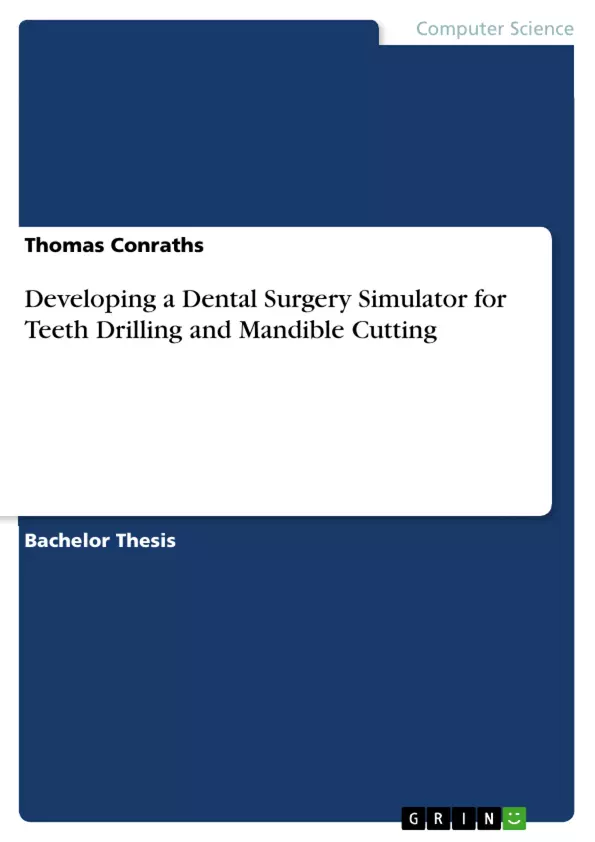This thesis focuses on virtual solid body manipulation with haptic feedback at real-time frame rates, such as teeth drilling and bone sawing.
Medical operations and surgical interventions require an enormous amount of skill and experience.
The traditional ways for medical students to obtain their surgical skills are either practicing on cadavers, animals or patients directly. However, all of these training methods bear several disadvantages.
With ongoing developments in the area of virtual reality (VR), virtual surgery simulators turned out to be a safe and repeatable alternative to the traditional training methods. A medical simulator provides a virtual training environment in which the trainee is able to interact with virtual objects and obtain physically plausible force feedback via a haptic feedback device connected to the simulator.
Inhaltsverzeichnis (Table of Contents)
- Introduction
- Preliminaries
- Object Representation
- Voxels
- Marching Cubes Algorithm
- Point Shells
- Polygonal Meshes
- Distance Fields
- Haptic Rendering
- Collision Detection
- Collision Response
- Direct Rendering vs. Virtual Coupling
- Rendering Frequencies
- Object Representation
- Related Work
- Methods and Implementation
- Object Representation
- Dental Tools
- Volume Object
- Implementation
- Dental Tools
- Volume Object
- Collision Detection
- Spatial Hashing
- Dental Bur
- Dental Saw
- Collision Response
- Handling Collisions
- Erosion
- Haptic Device
- Object Representation
- Evaluation
- Voxel Cube
- Tooth and Bur
- Setup
- Performance
- Simulation Quality
- Mandible and Saw
- Setup
- Performance
- Simulation Quality
- Conclusion and Future Work
- Conclusion
- Future Work
Zielsetzung und Themenschwerpunkte (Objectives and Key Themes)
This thesis aims to develop a dental surgery simulator for teeth drilling and mandible cutting. The simulator focuses on providing realistic haptic feedback to users through real-time collision detection and response mechanisms. The project aims to contribute to the advancement of virtual reality training methods for medical students and professionals. The key themes and objectives of this thesis include:- Developing a realistic and efficient virtual surgery simulator for teeth drilling and mandible cutting.
- Implementing real-time haptic rendering for providing physically plausible force feedback to users.
- Evaluating the performance and simulation quality of the developed simulator for different surgical scenarios.
- Exploring different object representations and collision detection techniques suitable for real-time virtual surgery simulations.
- Improving the efficiency and accuracy of collision response algorithms to enhance the user experience.
Zusammenfassung der Kapitel (Chapter Summaries)
- Introduction: This chapter introduces the concept of virtual surgery simulators as an alternative to traditional training methods. It highlights the need for realistic haptic feedback and discusses the importance of real-time collision detection and response in creating a convincing virtual environment.
- Preliminaries: This chapter explores various object representations commonly used in virtual reality applications, such as voxels, point shells, polygonal meshes, and distance fields. It also delves into the fundamental principles of haptic rendering, including collision detection and collision response, and discusses the importance of rendering frequencies for creating a seamless user experience.
- Related Work: This chapter presents a comprehensive overview of existing research related to virtual surgery simulators, focusing on various approaches, their advantages, and disadvantages. It provides context for the proposed methods and implementation in the thesis.
- Methods and Implementation: This chapter describes the methods and implementation details of the developed dental surgery simulator. It outlines the object representations used for dental tools and volume objects, the collision detection algorithms employed, and the collision response mechanisms implemented. The chapter focuses on the techniques used to achieve real-time performance and accurate simulation results.
- Evaluation: This chapter presents the evaluation of the developed simulator. It explores different scenarios involving teeth drilling and mandible cutting, analyzing the performance, simulation quality, and user experience. The chapter provides insights into the effectiveness and limitations of the proposed methods.
Schlüsselwörter (Keywords)
The primary keywords and focus topics of this thesis include virtual reality (VR), dental surgery simulation, haptic rendering, collision detection, collision response, object representation, voxel-based modeling, real-time performance, and user experience. The research focuses on developing an efficient and realistic virtual surgery simulator for training medical professionals in dental procedures, emphasizing the importance of accurate haptic feedback for enhancing the learning process.- Quote paper
- Thomas Conraths (Author), 2015, Developing a Dental Surgery Simulator for Teeth Drilling and Mandible Cutting, Munich, GRIN Verlag, https://www.grin.com/document/1194359



